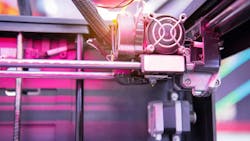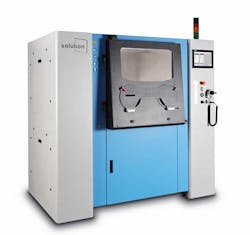Automating the Depowdering of 3D-Printed Parts Streamlines Production
3D-printed parts don’t just pop out of the printer ready to go. Almost all of them must go through some post-processing, such as removing supports, tumbling, sand blasting, CNC milling and chemical dips, usually to improve the surface finish. Reducing the time and cost of any of these post-production processes should make 3D printing more efficient and more popular among manufacturers of all types and sizes. That’s why several companies are developing new techniques for performing these tasks.
One German firm, Solukon Maschinenbau GmbH, is working on streamlining a process—depowdering —by making it more automated. The company’s engineers are already well along in developing a depowdering machine for metal parts made using powder-based printing such as laser powder bed fusion (LBPF). (Powder-based 3D printing technologies have about 90% of the 3D printer market). This is a logical goal for the company, the world’s leading designer and supplier of depowdering equipment. Its goal is to make depowdering less expensive, more consistent and safer than the current manual method of depowdering.
Depowdering Basics
Depowdering removes any leftover, unused metal powder trapped inside the 3D-printed part’s channels, openings and other cavities, as well as on surfaces. If it not done thoroughly, other post-production cleanup processes become more difficult, part quality falls, and technicians and equipment are exposed to the risk of explosions.
Currently, most depowdering is done manually by an operator manually knocking, brushing and blasting particles free and then using a compressed-air or inert-gas gun to blow off the particles. This is done in enclosures equipped with rubber gloves that let technicians use their hands inside the enclosure, without exposing themselves to health hazards from the fine dust or the risk of explosions the dust poses. And manual cleaning is often unable to remove stubborn powder consistently and reliably.
How well a part gets depowdered depends on the technician’s experience and skill level, as well as the part’s complexity. Size is not that much of an issue until parts get larger than about a cubic yard, then they are often too heavy to handle. But it’s a part’s complexity, such as the small, internal channels in heat exchangers, that present the real challenges for depowdering.
Depending on a part’s complexity part, manual depowdering can take several days, according to Solukon. All the variability in manually depowdering makes it hard to accurately predict the results and limits traceability, which also limits quality-control efforts.
Automating the Process
Solukon decided to work with Festo, a leader in industrial motion, to investigate ways to automate the process for maximum efficiency. “We are delighted to partner with Festo and have its innovative strength and expertise in automation for this project,” says Andreas Hartmann, CEO and technical director of Solukon.
Automating the depowdering process combines two depowdering methods, vibrations, and an air or inert gas gun in a protected, atmospherically controlled enclosure. It would also twist and turn the printed object or a batch of printed parts to give the gun access to various cavities in the object and to position the part it so that unused powder falls out of those cavities. Together, these make up Solukon’s automated Smart Powder Recuperation (SPR).
For SPR, one or more parts still attached to a build plate from the 3D printer are fastened to a turntable, part of a motion system that spins parts in two dimensions. In some versions of SPR two endless rotating axes with two programmable servo-drives can move the part along any imaginable path.
Electro-mechanical actuators attached to the turntable vibrate the part at frequencies that can reach into the ultrasonic. The vibrations fluidize the powder so that it easily runs out of any small gaps, long channels and other cavities. The part is then turned, spun and paused so that each cavity spends some time facing downward to let particles, now acting like a liquid, flow out of the part. And the part itself is positioned so that any loose powder will take the shortest path from inside the part to an exit point. Neither the 3D printing process or the vibrations harm or change the powder so it can be recycled and used again.
The vibrations’ frequency can be adjusted to maximize its effect on various cavities based on their shape and size. The sequence and pattern of vibrations, like the movement of the part, can be saved in a program. Moving and vibrating the part can be done manually or it can follow a preprogrammed motion profile created for specific 3D-printed parts.
SPR also has a robotic arm holding the air/gas gun. It can be programmed to move in concert with the part going through its choreographed motions and use its stream of air or gas to remove particles from the part. It is also possible for the arm to position itself to send a blast of pressurized air or gas into a channel or cavity to check to determine there are no particles still stuck in them.
Once technicians program the motions of the part and gun, as well as the sequence of vibrations used to fluidize particles, the machine can consistently depowder 3D prints of the same part using those same programs.
There are several subsystems that need to be developed and added to the automated depowderer before it is ready for the market. This includes doors for loading and unloading printed parts before and after depowdering and automated clamps for holding the build plate and printed parts in place. These speed the automated process.
The team also wants to add artificial intelligence to the process. It would analyze computer or CAD models of the printed part and create a path for the air gun to follow, a series of moves for the printed part which would make its cavities accessible to the air gun and let gravity drain those cavities of unused powder.
When the project is completed, the final device could be used as a testbed to confirm the various components and the entire machine works or as a prototype for a new model of printer.
Overall, once on the market, the automated depowdering machine should lower the cost of 3D-printed parts. Depowdering parts should also become more consistent as removing unused powder becomes independent of the operator’s skill and experience.
Watch an animation of the SFM-AT800 depowdering machine designed by Solukon and Festo below:

